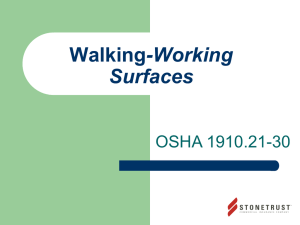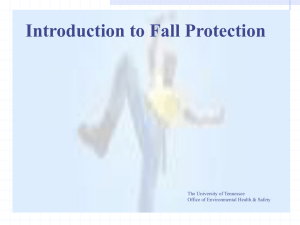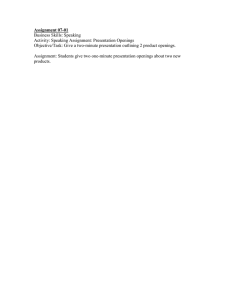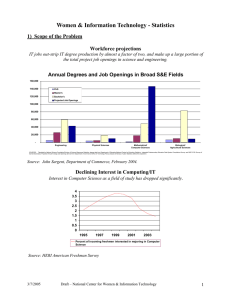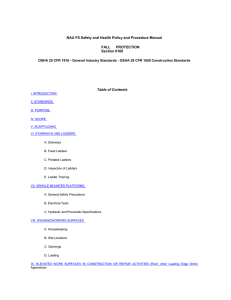Appendix F Document
advertisement
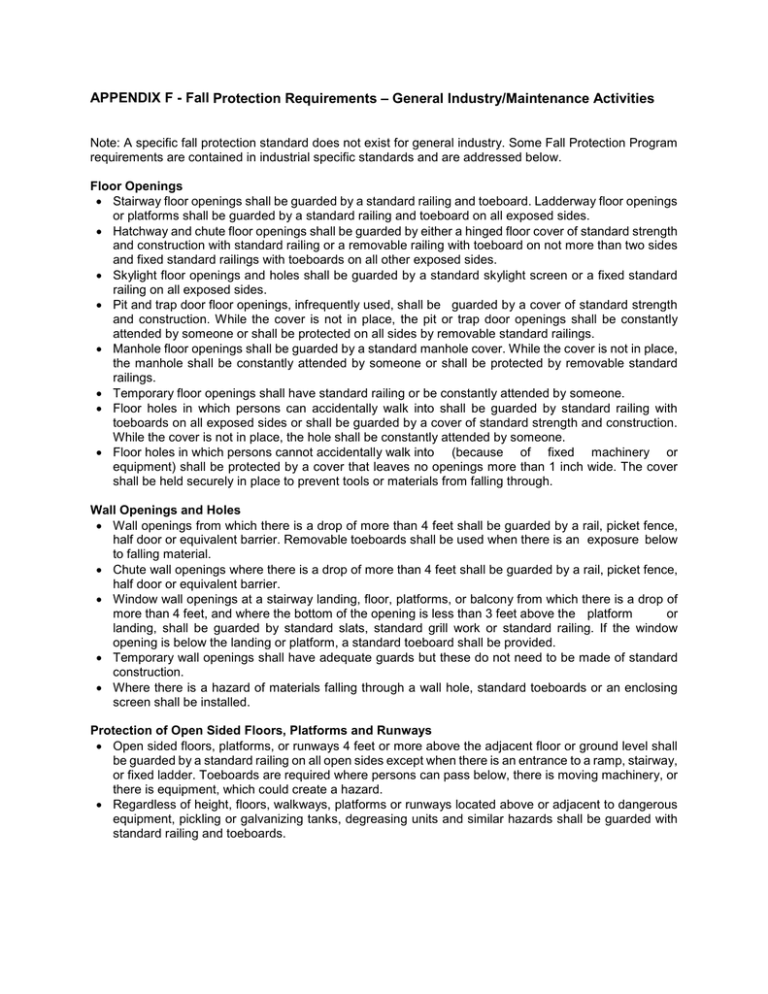
APPENDIX F - Fall Protection Requirements – General Industry/Maintenance Activities Note: A specific fall protection standard does not exist for general industry. Some Fall Protection Program requirements are contained in industrial specific standards and are addressed below. Floor Openings • Stairway floor openings shall be guarded by a standard railing and toeboard. Ladderway floor openings or platforms shall be guarded by a standard railing and toeboard on all exposed sides. • Hatchway and chute floor openings shall be guarded by either a hinged floor cover of standard strength and construction with standard railing or a removable railing with toeboard on not more than two sides and fixed standard railings with toeboards on all other exposed sides. • Skylight floor openings and holes shall be guarded by a standard skylight screen or a fixed standard railing on all exposed sides. • Pit and trap door floor openings, infrequently used, shall be guarded by a cover of standard strength and construction. While the cover is not in place, the pit or trap door openings shall be constantly attended by someone or shall be protected on all sides by removable standard railings. • Manhole floor openings shall be guarded by a standard manhole cover. While the cover is not in place, the manhole shall be constantly attended by someone or shall be protected by removable standard railings. • Temporary floor openings shall have standard railing or be constantly attended by someone. • Floor holes in which persons can accidentally walk into shall be guarded by standard railing with toeboards on all exposed sides or shall be guarded by a cover of standard strength and construction. While the cover is not in place, the hole shall be constantly attended by someone. • Floor holes in which persons cannot accidentally walk into (because of fixed machinery or equipment) shall be protected by a cover that leaves no openings more than 1 inch wide. The cover shall be held securely in place to prevent tools or materials from falling through. Wall Openings and Holes • Wall openings from which there is a drop of more than 4 feet shall be guarded by a rail, picket fence, half door or equivalent barrier. Removable toeboards shall be used when there is an exposure below to falling material. • Chute wall openings where there is a drop of more than 4 feet shall be guarded by a rail, picket fence, half door or equivalent barrier. • Window wall openings at a stairway landing, floor, platforms, or balcony from which there is a drop of more than 4 feet, and where the bottom of the opening is less than 3 feet above the platform or landing, shall be guarded by standard slats, standard grill work or standard railing. If the window opening is below the landing or platform, a standard toeboard shall be provided. • Temporary wall openings shall have adequate guards but these do not need to be made of standard construction. • Where there is a hazard of materials falling through a wall hole, standard toeboards or an enclosing screen shall be installed. Protection of Open Sided Floors, Platforms and Runways • Open sided floors, platforms, or runways 4 feet or more above the adjacent floor or ground level shall be guarded by a standard railing on all open sides except when there is an entrance to a ramp, stairway, or fixed ladder. Toeboards are required where persons can pass below, there is moving machinery, or there is equipment, which could create a hazard. • Regardless of height, floors, walkways, platforms or runways located above or adjacent to dangerous equipment, pickling or galvanizing tanks, degreasing units and similar hazards shall be guarded with standard railing and toeboards. Fixed Industrial Stairs • Every flight of stairs having 4 or more risers shall be equipped with standard stair railings or standard handrails. Standard railings shall be installed on the open sides of all stairways and stair platforms, which are located 4 or more feet above a lower level even if there are less than 4 risers in the flight of stairs. Fixed Ladders • Ladder safety devices (life belts, friction brakes, sliding attachments) are required on tower, water tanks and chimney ladders that are over 20 feet, unless cage protection is provided. Portable Ladders • The IU Portable Ladder Safety Program covers the following ladders: step, extension, and other portable ladders. Users must be able to recognize and avoid ladder hazards and be aware of safe practices in setting up, storing, and working with ladders. See the IU Portable Ladder Safety Program for additional information Scaffolds • Guardrails, midrails, and toeboards shall be installed on open sides of scaffolds which are 10 feet or greater in height. Full body harnesses and lifelines are required for suspension scaffolds and boatswains chairs. See the IU Scaffold Safety Program for additional information. Aerial Lifts • Employees working in a bucket truck, boom lift, or scissor lift are required to wear a full body harnesses and lanyards. See the IU’s Aerial Lift Program for additional information.
